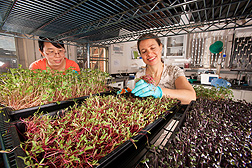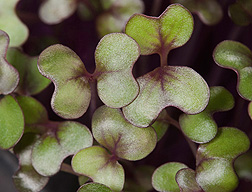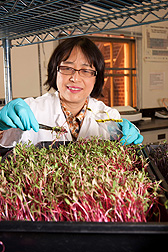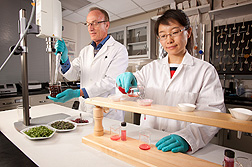Specialty Greens Pack a Nutritional Punch
|
|
“Microgreens” is a marketing term used to describe tiny, tender, edible greens that germinate in soil or a soil substitute from the seeds of vegetables and herbs. Smaller than “baby greens,” and harvested later than “sprouts,” microgreens can provide a variety of leaf flavors, such as sweet and spicy. They are also known for their various colors and textures. Among upscale markets, they are now considered a specialty genre of greens that are good for garnishing salads, soups, plates, and sandwiches.
Microgreens began showing up on chefs’ menus as early as the 1980s, in San Francisco, California, according to a local industry source. Today, the U.S. microgreens industry consists of a variety of seed companies and growers.
A microgreen has a single central stem, which has been cut just above the soil during harvesting—in fact, home gardeners often snip them with scissors. The seedlings are well suited for local growers because microgreens are harvested just 7 to 14 days after germination when the cotyledons (seed leaves) have fully developed and before the true leaves have expanded.
Now, a team of Agricultural Research Service scientists and colleagues has published several studies that shed light not only on microgreens’ nutritional benefits, but also on their complex shelf-life requirements.
Tiny But Mighty Produce
Microgreens are usually harvested at 1 to 3 inches tall and, depending on the species, are sold with the stem attached to the cotyledons. Plants with two cotyledons are called “dicots,” and those are the leaves that the scientists studied. Plants with a single cotyledon are “monocots.”
Crops that germinate easily and grow quickly are good candidates for growing as microgreens. ARS plant physiologist Gene Lester led a team of scientists who analyzed the key nutrients in different varieties of vegetable microgreens. The study results could be used as a reference in estimating the amounts and adequacies of specific vitamins that are gained when consumers eat microgreens, according to the authors.
The researchers determined the concentration of essential vitamins and carotenoids in 25 commercially available varieties of microgreens. Key nutrients measured were ascorbic acid (vitamin C), tocopherols (vitamin E), phylloquinone (vitamin K), and beta-carotene (a vitamin A precursor), plus other related carotenoids in the cotyledons.
The team showed that different microgreens contained widely differing amounts of vitamins and carotenoids. Total vitamin C content ranged from 20 to 147 milligrams (mg) per 100 grams of cotyledon fresh weight, depending on which plant species was being tested. The amounts of the carotenoids beta-carotene, lutein/zeaxanthin, and violaxanthin ranged from about 0.6 mg to 12.1 mg per 100 grams of fresh weight. For comparison, an average apple weighs 100-150 grams.
Among the 25 microgreens tested, red cabbage, cilantro, garnet amaranth, and green daikon radish had the highest concentrations of vitamin C, carotenoids, vitamin K, and vitamin E, respectively. In general, microgreens contained considerably higher levels of vitamins and carotenoids—about five times greater—than their mature plant counterparts, an indication that microgreens may be worth the trouble of delivering them fresh during their short lives.
Growing, harvesting, and handling conditions may have a considerable effect on nutrient content. Additional studies are needed to evaluate the effect of these agricultural practices on nutrient retention. The study was published in 2012 in the Journal of Agricultural and Food Chemistry.
Buckwheat Is Not Just for Pancakes
Buckwheat “seeds” look like cereal grains, but they are actually dry, hard-covered fruits called “achenes.” Each achene contains one small seed. During germination, the seed bears cotyledons, thus accounting for buckwheat’s candidacy as a microgreen.
Gram for gram, buckwheat has almost the same amount of protein as oats, according to the ARS National Nutrient Database for Standard Reference. It’s also gluten free.
In a study headed by ARS food technologist Yaguang Luo with the Food Quality Laboratory in Beltsville, Maryland, the researchers focused on buckwheat microgreens, which, in addition to high protein, are considered high in antioxidants, flavonoids, carotenoids, and alpha-tocopherol. Like all microgreens, buckwheat microgreens typically have only a few days of shelf life. The team found that storage temperature and atmospheric composition are key variables when it comes to fresh-cut buckwheat microgreens. They extended shelf life by storing the greens at a relatively low 5°C and by elevating CO2 and reducing O2.
|
|
The researchers also fine-tuned packages to provide the optimal atmospheric composition required to extend the shelf life of buckwheat microgreens. Commercial microgreens are most often stored in plastic clamshell containers, which do not provide the right balance of O2 and CO2 for live greens to “breathe.” Among package materials called “films,” differences in permeability are referred to as “oxygen transmission rate.”
The researchers found that buckwheat microgreens packaged in films with an oxygen transmission rate of 225 cubic centimeters per square inch per day had a fresher appearance and better cell membrane integrity than those packaged in other films tested. Following these steps, the team maintained acceptable buckwheat microgreen quality for more than 14 days—a significant extension, according to authors. The study was published in LWT-Food Science and Technology in 2013.
“Due to their short shelf life and growing requirements, bringing safe, high-quality microgreens to market can be relatively complex and labor-intensive,” says Luo. “More studies are needed to understand their postharvest processing requirements.” Studies on individual plant species grown and harvested as microgreens are helping to fill the dearth of information on this budding industry, which will ultimately assist growers, grocers, and chefs.—By Rosalie Marion Bliss, Agricultural Research Service Information Staff.
This research is part of Quality and Utilization of Agricultural Products, an ARS national program (#306) described at www.nps.ars.usda.gov.
Yaguang Luo and Gene Lester are with the USDA-ARS Food Quality Laboratory, 10300 Baltimore Ave., Beltsville, MD 20705-2350; (301) 504-6186 [Luo], (301) 504-5981 [Lester].
"Specialty Greens Pack a Nutritional Punch" was published in the January 2014 issue of Agricultural Research magazine.










